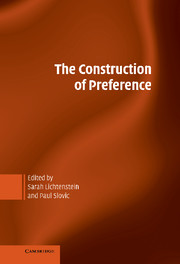Book contents
- Frontmatter
- Contents
- Contributors
- Preface
- Acknowledgments
- I INTRODUCTION
- II PREFERENCE REVERSALS
- 2 Relative Importance of Probabilities and Payoffs in Risk Taking
- 3 Reversals of Preference Between Bids and Choices in Gambling Decisions
- 4 Response-Induced Reversals of Preference in Gambling: An Extended Replication in Las Vegas
- 5 Economic Theory of Choice and the Preference Reversal Phenomenon
- III PSYCHOLOGICAL THEORIES OF PREFERENCE REVERSALS
- IV EVIDENCE FOR PREFERENCE CONSTRUCTION
- V THEORIES OF PREFERENCE CONSTRUCTION
- VI AFFECT AND REASON
- VII MISWANTING
- VIII CONTINGENT VALUATION
- IX PREFERENCE MANAGEMENT
- References
- Index
4 - Response-Induced Reversals of Preference in Gambling: An Extended Replication in Las Vegas
Published online by Cambridge University Press: 05 June 2012
- Frontmatter
- Contents
- Contributors
- Preface
- Acknowledgments
- I INTRODUCTION
- II PREFERENCE REVERSALS
- 2 Relative Importance of Probabilities and Payoffs in Risk Taking
- 3 Reversals of Preference Between Bids and Choices in Gambling Decisions
- 4 Response-Induced Reversals of Preference in Gambling: An Extended Replication in Las Vegas
- 5 Economic Theory of Choice and the Preference Reversal Phenomenon
- III PSYCHOLOGICAL THEORIES OF PREFERENCE REVERSALS
- IV EVIDENCE FOR PREFERENCE CONSTRUCTION
- V THEORIES OF PREFERENCE CONSTRUCTION
- VI AFFECT AND REASON
- VII MISWANTING
- VIII CONTINGENT VALUATION
- IX PREFERENCE MANAGEMENT
- References
- Index
Summary
In a previous paper, Lichtenstein and Slovic (1971) argued that variations in response mode cause fundamental changes in the way people process information, and thus alter the resulting decisions. Evidence supporting that view came from three experiments in which Ss chose their preferred bets from pairs of bets and later placed monetary values (prices) on each bet separately. In every pair of bets, one, designated the $ bet, featured a large amount to win; the other, called the P bet, featured a large probability of winning. Many Ss, after choosing a P bet, would frequently place a higher price on the $ bet. The authors hypothesized that the following process leads to such reversals of preference. When pricing an attractive bet, Ss use the amount to win as a natural starting point or anchor. Then they adjust downward the amount to win in order to incorporate the other aspects of the bet. This adjustment may be rather crude and insufficient, making the starting point – amount to win – the primary determiner of the response. Thus, the $ bets, with their large winning payoffs, receive higher prices than the P bets. This bias would not be expected in choice responses, where the amount to win does not dominate decisions (Slovic & Lichtenstein, 1968).
The previous study (Lichtenstein & Slovic, 1971) used gambles with positive expected value (EV) exclusively. A more stringent test of the reversal effect was provided in the present study by the inclusion of unattractive (negative-EV) bets.
Information
- Type
- Chapter
- Information
- The Construction of Preference , pp. 69 - 76Publisher: Cambridge University PressPrint publication year: 2006
Accessibility standard: Unknown
Why this information is here
This section outlines the accessibility features of this content - including support for screen readers, full keyboard navigation and high-contrast display options. This may not be relevant for you.Accessibility Information
- 3
- Cited by
